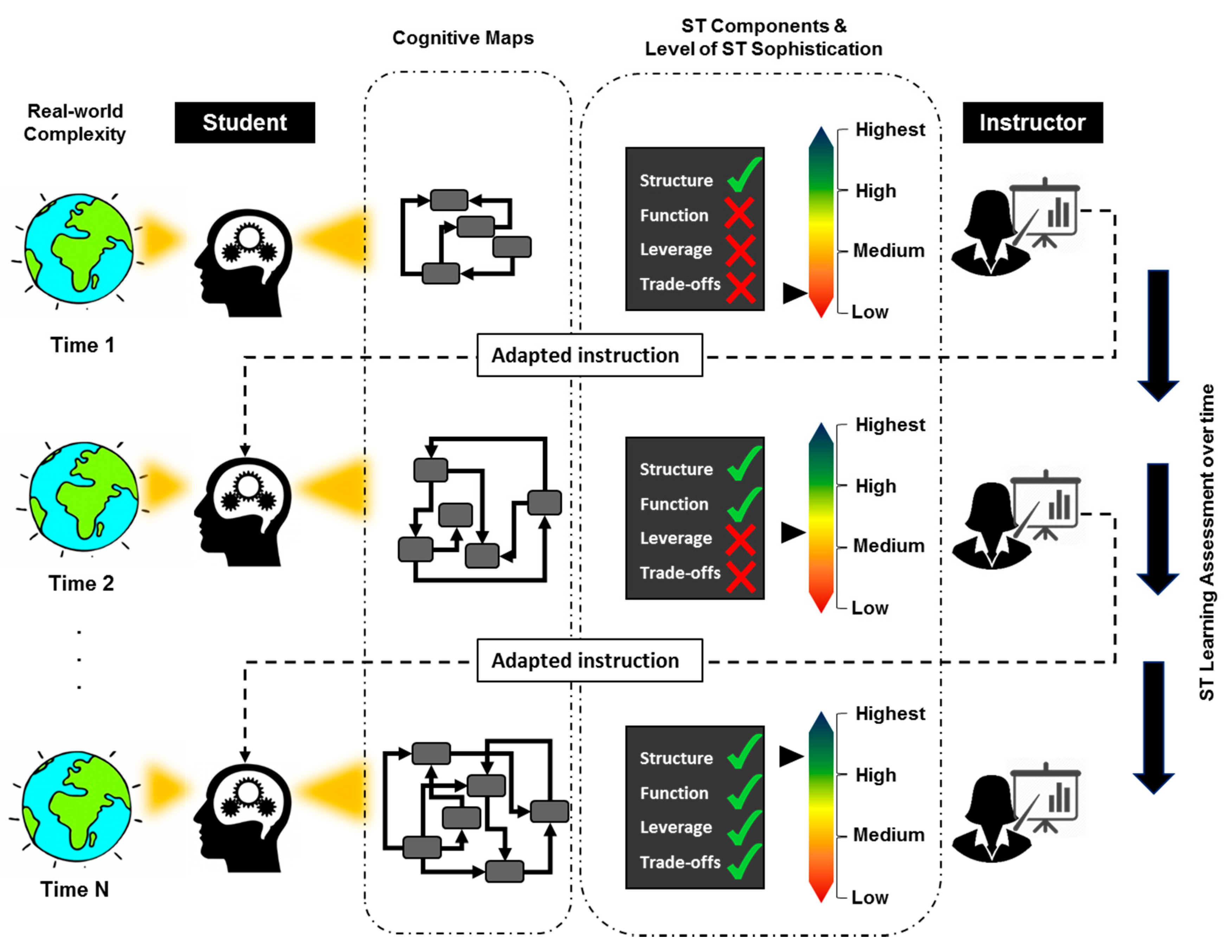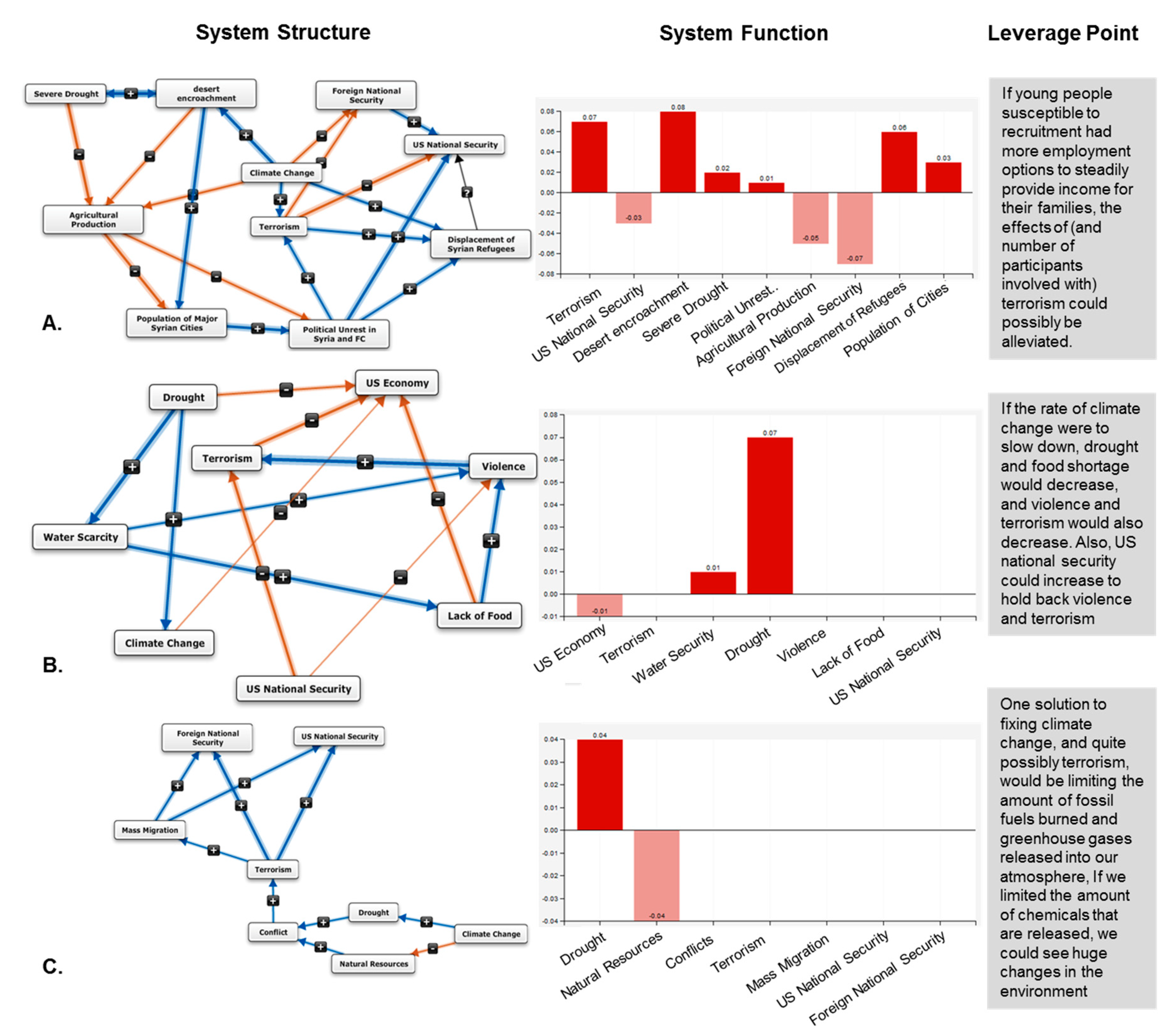Assessing (Social-Ecological) Systems Thinking by Evaluating Cognitive Maps
Abstract
:1. Introduction
Systems Thinking on a Continuum
2. Teaching and Evaluating Four Dimensions of Systems Thinking
2.1. System Structure
2.2. System Function
2.3. Leverage Points
2.4. Trade-Offs
3. Assessing Systems Thinking by Evaluating Cognitive Maps
Case Study of Teaching Social–Ecological (Systems) Thinking
4. Conclusions
Focusing on Assessment to Determine Best Practice for Teaching Systems Thinking
Author Contributions
Funding
Conflicts of Interest
References
- Vincent, S. Interdisciplinary Environmental Education on the Nation’s Campuses: Elements of Field Identity and Curriculum Design; National Council for Science and the Environment: Washington, DC, USA, 2010. [Google Scholar]
- Vincent, S.; Focht, W. Interdisciplinary environmental education: Elements of field identity and curriculum design. J. Environ. Stud. Sci. 2011, 1, 14–35. [Google Scholar] [CrossRef]
- Phelan, L.; McBain, B.; Ferguson, A.; Brown, P.; Brown, V.; Hay, I.; Horsfield, R.; Taplin, R. Learning and Teaching Academic Standards Statement for Environment and Sustainability; Office for Learning and Teaching: Sydney, Australia, 2015. [Google Scholar]
- Wei, C.A.; Burnside, W.R.; Che-Castaldo, J.P. Teaching socio-environmental synthesis with the case studies approach. J. Environ. Stud. Sci. 2015, 5, 42–49. [Google Scholar] [CrossRef]
- Wiek, A.; Withycombe, L.; Redman, C.L. Key competencies in sustainability: A reference framework for academic program development. Sustain. Sci. 2011, 6, 203–218. [Google Scholar] [CrossRef]
- Rittel, H.W.; Webber, M.M. Dilemmas in a general theory of planning. Policy Sci. 1973, 4, 155–169. [Google Scholar] [CrossRef]
- Gray, S.; Jordan, R.; Crall, A.; Newman, G.; Hmelo-Silver, C.; Huang, J.; Novak, W.; Mellor, D.; Frensley, T.; Singer, A.; et al. Combining participatory modelling and citizen science to support volunteer conservation action. Biol. Conserv. 2017, 208, 76–86. [Google Scholar] [CrossRef] [Green Version]
- Hicks, D.; Bord, A. Learning about global issues: Why most educators only make things worse. Environ. Educ. Res. 2011, 7, 413–425. [Google Scholar] [CrossRef]
- Jensen, B. Knowledge, action and pro-environmental behaviour. Environ. Educ. Res. 2002, 8, 325–334. [Google Scholar] [CrossRef]
- Meadows, D.H.; Wright, D. Thinking in Systems: A primer; Chelsea Green Publishing: White River Junction, VT, USA, 2008. [Google Scholar]
- Arnold, R.D.; Wade, J.P. A Definition of Systems Thinking: A Systems Approach. Procedia Comput. Sci. 2015, 44, 669–678. [Google Scholar] [CrossRef] [Green Version]
- Hooper, M.; Stave, K.A. Assessing the Effectiveness of Systems Thinking Interventions in the Classroom. In Proceedings of the 26th International Conference of the System Dynamics Society, Athens, Greece, 20–24 July 2008; Available online: http://www.systemdynamics.org/conferences/2008/proceed/index.htm (accessed on 1 May 2019).
- Pennington, D.D.; Vincent, S.; Thompson, K.; Gosselin, D.C. EMBeRS: A Best Practice for Enabling Interdisciplinary Learning, Synthesis and Convergence. In Proceedings of the AGU Fall Meeting Abstracts 2018, Washington, DC, USA, 10–14 December 2018. [Google Scholar]
- Dauer, J.T.; Long, T.M. Long-term conceptual retrieval by college biology majors following model-based instruction. J. Res. Sci. Teach. 2015, 52, 1188–1206. [Google Scholar] [CrossRef]
- Stave, K.; Hopper, M. What Constitutes Systems Thinking? A Proposed Taxonomy. In Proceedings of the 25th International Conference of the Systems Dynamics Society, Boston, MA, USA, 29 July–7 August 2007. [Google Scholar]
- Vattam, S.S.; Goel, A.K.; Rugaber, S.; Hmelo-Silver, C.E.; Jordan, R.; Gray, S.; Sinha, S. Understanding complex natural systems by articulating structure-behavior-function models. J. Educ. Technol. Soc. 2011, 14, 66–81. [Google Scholar]
- Pullan, W.; Bhadeshia, H. Structure: In Science and Art; Cambridge University Press: Cambridge, UK, 2000; Volume 12. [Google Scholar]
- Hmelo-Silver, C.E.; Pfeffer, M.G. Comparing expert and novice understanding of a complex system from the perspective of structures, behaviors, and functions. Cogn. Sci. 2004, 28, 127–138. [Google Scholar] [CrossRef]
- Giabbanelli, P.J.; Gray, S.A.; Aminpour, P. Combining fuzzy cognitive maps with agent-based modeling: Frameworks and pitfalls of a powerful hybrid modeling approach to understand human-environment interactions. Environ. Model. Softw. 2017, 95, 320–325. [Google Scholar] [CrossRef]
- Sodhi, N.S.; Ehrlich, P.R. Conservation Biology for All; Oxford University Press: Oxford, UK, 2010. [Google Scholar]
- Gray, S.; Gray, S.; De Kok, J.L.; Helfgott, A.; O’Dwyer, B.; Jordan, R.; Nyaki, A. Using fuzzy cognitive mapping as a participatory approach to analyze change, preferred states, and perceived resilience of social-ecological systems. Ecol. Soc. 2015, 20. [Google Scholar] [CrossRef]
- Walker, B.; Carpenter, S.; Anderies, J.; Abel, N.; Cumming, G.; Janssen, M.; Lebel, L.; Norberg, J.; Peterson, G.D.; Pritchard, R. Resilience management in social–ecological systems: A working hypothesis for a participatory approach. Conserv. Ecol. 2002, 6, 14. [Google Scholar] [CrossRef]
- Batie, S. Wicked problems and applied economics. Am. J. Agric. Econ. 2008, 90, 1176–1198. [Google Scholar] [CrossRef]
- Croasdell, D.T.; Freeman, L.A.; Urbaczewski, A. Concept maps for teaching and assessment. Commun. Assoc. Inf. Syst. 2003, 12, 396–405. [Google Scholar] [CrossRef]
- Jones, N.; Ross, H.; Lynam, T.; Perez, P.; Leitch, A. Mental models: An interdisciplinary synthesis of theory and methods. Ecol. Soc. 2011, 16, 46. [Google Scholar] [CrossRef]
- Deaton, M.L.; Wei, C.A.; Weng, Y. Concept Mapping: A Technique for Teaching about Systems and Complex Problems. 2016. Available online: http://www.sesync.org/concept-mapping-a-technique-for-teaching-about-systems-and-complex-problems (accessed on 27 June 2019).
- Stander, E.; Aronson, M. Designing an Urban Green Infrastructure Network: Balancing Biodiversity and Stakeholder Needs. Available online: http://www.sesync.org/designing-an-urban-green-infrastructure-network-balancing-biodiversity-and-stakeholder-needs-2014-4 (accessed on 2 January 2014).
- Dauer, J.T.; Momsen, J.L.; Speth, E.B.; Makohon-Moore, S.C.; Long, T.M. Analyzing change in students’ gene-to-evolution models in college-level introductory biology. J. Res. Sci. Teach. 2013, 50, 639–659. [Google Scholar] [CrossRef]
- Kelley, C.P.; Mohtadi, S.; Cane, M.A.; Seager, R.; Kushnir, Y. Climate change in the Fertile Crescent and implications of the recent Syrian drought. Proc. Natl. Acad. Sci. USA 2015, 112, 3241–3246. [Google Scholar] [CrossRef] [PubMed] [Green Version]
- Gray, S.A.; Gray, S.; Cox, L.J.; Henly-Shepard, S. Mental modeler: A fuzzy-logic cognitive mapping modeling tool for adaptive environmental management. In Proceedings of the 2013 IEEE 46th Hawaii International Conference on System Sciences, Wailea, HI, USA, 7–10 January 2013; pp. 965–973. [Google Scholar]
- Kosko, B. Fuzzy cognitive maps. Int. J. Man-Mach. Stud. 1986, 24, 65–75. [Google Scholar] [CrossRef]
- Cholewicki, J.; Popovich, J.M., Jr.; Aminpour, P.; Gray, S.A.; Lee, A.S.; Hodges, P.W. Development of a collaborative model of low back pain: Report from the 2017 NASS consensus meeting. Spine J. 2019, 19, 1029–1040. [Google Scholar] [CrossRef] [PubMed]
- Hodges, P.W.; Cholewicki, J.; Popovich, J.M., Jr.; Lee, A.S.; Aminpour, P.; Gray, S.A.; Fryer, G.; Degenhardt, B.F.; Cusi, M.; Cibulka, M.T.; et al. Building a collaborative model of sacro-iliac joint dysfunction and pelvic girdle pain to understand the diverse perspectives of experts. PM&R 2019. [Google Scholar] [CrossRef]
- Gunawansa, A.; Kua, H.W. A comparison of climate change mitigation and adaptation strategies for the construction industries of three coastal territories. Sustain. Dev. 2014, 22, 52–62. [Google Scholar] [CrossRef]
- Saed, B.; Afshar, A.; Jalali, M.; Ghoreishi, M.; Aminpour, P.A. Water Footprint Based Hydro-Economic Model for Minimizing the Blue Water to Green Water Ratio in the Zarrinehrud River-Basin in Iran. AgriEngineering 2019, 1, 58–74. [Google Scholar] [CrossRef]
- Mulvaney, K.K.; Pulver, S.; Ryan, C.M.; Weng, Y. Using Systems Maps to Analyze Complex Social-Environmental Issues: A Case Study of Geoduck Aquaculture in the Puget Sound. Available online: http://www.sesync.org/using-system-maps-to-analyze-complex-social-environmental-issues-a-case-study-of-geoduck-aquaculture (accessed on 23 November 2014).
- National Research Council. National Science Education Standards; National Academies Press: Washington, DC, USA, 1996. [Google Scholar]
- Linn, M.C.; Lee, H.S.; Tinker, R.; Husic, F.; Chiu, J.L. Teaching and assessing knowledge integration in science. Science 2006, 313, 1049–1050. [Google Scholar] [CrossRef]


| Components of ST | Learning Outcomes | Level of ST Sophistication |
|---|---|---|
| Structure | Recognize and define basic systems language, properties, and behaviors of basic systems. | Low–Medium |
| Identify and explain system archetypes and be able to explain their impacts. | ||
| Analyze system components—social and ecological elements, their connections, slow and fast drivers, endogenous and exogenous drivers, and scales above and below. | ||
| Apply systems thinking/mapping to explain the interconnectedness of human and natural systems. | ||
| Function | Identify functions within a system, anthropocentric and not. | Medium–High |
| Evaluate how changing function influences other system structures. | ||
| Leverage points | Apply systems thinking/mapping to generate multiple scenarios to inform a decision-making process around human and natural systems. | High |
| Practice anticipation—i.e., forward thinking in research and engagement—in addition to reaction. | ||
| Identify leverage points for changes in management. | ||
| Trade-offs | Explain that any sustainability issue both influences and is influenced by multiple spatial and temporal scales given the interconnectedness of social–ecological systems. | Highest |
| Recognize that systems are nested and explain cross-scale dynamics. | ||
| Analyze the trade-offs a management decision or exogenous shock may result in within a social–ecological system, and at the scales above and below. |
© 2019 by the authors. Licensee MDPI, Basel, Switzerland. This article is an open access article distributed under the terms and conditions of the Creative Commons Attribution (CC BY) license (http://creativecommons.org/licenses/by/4.0/).
Share and Cite
Gray, S.; Sterling, E.J.; Aminpour, P.; Goralnik, L.; Singer, A.; Wei, C.; Akabas, S.; Jordan, R.C.; Giabbanelli, P.J.; Hodbod, J.; et al. Assessing (Social-Ecological) Systems Thinking by Evaluating Cognitive Maps. Sustainability 2019, 11, 5753. https://doi.org/10.3390/su11205753
Gray S, Sterling EJ, Aminpour P, Goralnik L, Singer A, Wei C, Akabas S, Jordan RC, Giabbanelli PJ, Hodbod J, et al. Assessing (Social-Ecological) Systems Thinking by Evaluating Cognitive Maps. Sustainability. 2019; 11(20):5753. https://doi.org/10.3390/su11205753
Chicago/Turabian StyleGray, Steven, Eleanor J. Sterling, Payam Aminpour, Lissy Goralnik, Alison Singer, Cynthia Wei, Sharon Akabas, Rebecca C. Jordan, Philippe J. Giabbanelli, Jennifer Hodbod, and et al. 2019. "Assessing (Social-Ecological) Systems Thinking by Evaluating Cognitive Maps" Sustainability 11, no. 20: 5753. https://doi.org/10.3390/su11205753
APA StyleGray, S., Sterling, E. J., Aminpour, P., Goralnik, L., Singer, A., Wei, C., Akabas, S., Jordan, R. C., Giabbanelli, P. J., Hodbod, J., Betley, E., & Norris, P. (2019). Assessing (Social-Ecological) Systems Thinking by Evaluating Cognitive Maps. Sustainability, 11(20), 5753. https://doi.org/10.3390/su11205753






